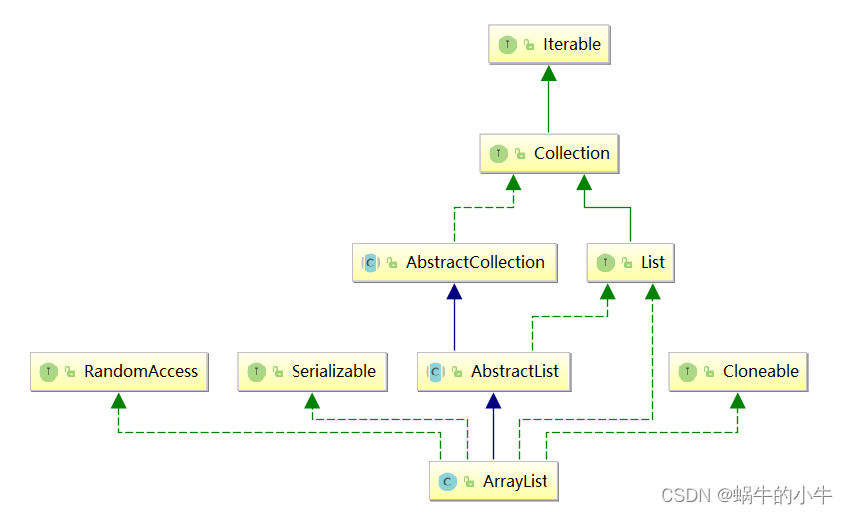文章目录
1.类继承结构

2.重要成员变量
/**
* 数组默认大小.
*/
private static final int DEFAULT_CAPACITY = 10;
/**
* 空数组. new ArrayList(0)时使用它
*/
private static final Object[] EMPTY_ELEMENTDATA = {};
/**
* 存储具体数据的数组对象
*/
transient Object[] elementData;
/**
* 数组中元素个数
*/
private int size;
/**
* 数组被修改次数,对数组添加或者移除元素时 加1
*/
protected transient int modCount = 0;
3.重要方法
3.1 get(int index)
public E get(int index) {
// 是否越界
rangeCheck(index);
// 直接通过数组下标获取
return elementData(index);
}
3.2 add(E e)
public boolean add(E e) {
// 确保容量够用
ensureCapacityInternal(size + 1);
// 直接在数组后面添加入当前元素e
elementData[size++] = e;
return true;
}
private void ensureExplicitCapacity(int minCapacity) {
modCount++;
// 当前不够位置插入,需要扩容,进入grow方法
if (minCapacity - elementData.length > 0)
grow(minCapacity);
}
private void grow(int minCapacity) {
int oldCapacity = elementData.length;
// oldCapacity >> 1 表示原容量转二进制后右移1位
// 10 二进制是1010 右移一位即 0101 得到 newCapacity = 10 + 5,扩容后是原容量的1.5倍
int newCapacity = oldCapacity + (oldCapacity >> 1);
if (newCapacity - minCapacity < 0)
// 如果扩容后比需要的容量小,则取minCapacity
newCapacity = minCapacity;
if (newCapacity - MAX_ARRAY_SIZE > 0)
// 是否大于最大范围限制
newCapacity = hugeCapacity(minCapacity);
// minCapacity is usually close to size, so this is a win:
// 扩容后生成一个新数组替换掉原来的
elementData = Arrays.copyOf(elementData, newCapacity);
}
3.3 add(int index, E e)
public void add(int index, E element) {
// 检查是否越界
rangeCheckForAdd(index);
// 扩容是否需要
ensureCapacityInternal(size + 1); // Increments modCount!!
// 从数组index位开始往后移动一位,一共移动 size - index个元素
System.arraycopy(elementData, index, elementData, index + 1,
size - index);
// index空出来后写入 要插入的元素
elementData[index] = element;
size++;
}
3.4 remove(int index)
public E remove(int index) {
rangeCheck(index);
modCount++;
// 返回当前元素
E oldValue = elementData(index);
int numMoved = size - index - 1;
if (numMoved > 0)
// 说明要移除的不是最后一位
//需要将index之后元素都往前移动一位,共移动size - index - 1个元素
System.arraycopy(elementData, index+1, elementData, index,
numMoved);
// 最后一位设置为null
elementData[--size] = null;
return oldValue;
}
3.5 remove(Object o)
public boolean remove(Object o) {
if (o == null) {
// 删除null元素的情况
for (int index = 0; index < size; index++)
if (elementData[index] == null) {
fastRemove(index);
return true;
}
} else {
// 非null元素
for (int index = 0; index < size; index++)
// 遍历找到相等元素,然后传入index去移除
if (o.equals(elementData[index])) {
fastRemove(index);
return true;
}
}
return false;
}
private void fastRemove(int index) {
modCount++;
int numMoved = size - index - 1;
if (numMoved > 0)
// 这里跟remove(index)一样
System.arraycopy(elementData, index+1, elementData, index,
numMoved);
elementData[--size] = null; // 最后一位设置为null
}
3.6 addAll(Collection<? extends E> c)
public boolean addAll(Collection<? extends E> c) {
Object[] a = c.toArray();
int numNew = a.length;
// 是否扩容
ensureCapacityInternal(size + numNew); // Increments modCount
// 从原数组末尾开始放入即将要加入的数组c,操作次数为c数组长度,即numNew
System.arraycopy(a, 0, elementData, size, numNew);
// 总数 = 原数组长度 + 数组c的长度
size += numNew;
return numNew != 0;
}
3.7 addAll(int index, Collection<? extends E> c)
public boolean addAll(int index, Collection<? extends E> c) {
rangeCheckForAdd(index);
Object[] a = c.toArray();
int numNew = a.length;
ensureCapacityInternal(size + numNew);
int numMoved = size - index;
if (numMoved > 0)
// 非插入末尾的情况
// 原数组index以及之后的元素往后移动到目的位置:index + numNew,一个操作numMoved 个元素
System.arraycopy(elementData, index, elementData, index + numNew,
numMoved);
// 上面腾出来位置后,腾出位置大小为a数组的元素个数,将新插入的数组a放到原数组中
System.arraycopy(a, 0, elementData, index, numNew);
size += numNew;
return numNew != 0;
}
4. 最大长度
ArrayList最大长度
/**
* The maximum size of array to allocate.
* Some VMs reserve some header words in an array.
* Attempts to allocate larger arrays may result in
* OutOfMemoryError: Requested array size exceeds VM limit
*/
private static final int MAX_ARRAY_SIZE = Integer.MAX_VALUE - 8;
即有符号整数的最大长度2^31 - 1 ,这里减去8是因为一些jvm的数组结构会包含头部信息,这样做目的是减少内存溢出的概率。 其实最大长度是可以到Integer.MAX_VALUE的。
5. 为什么用transient修饰
我们知道transient 关键字修饰的变量 不会 被序列化为字节流,ArrayList内部重写了writeObject()和readObject()方法,所以本身也是能序列化的,但是它并非暴力的把整个数组序列化了,因为一般真正存储的元素个数都是小于数组大小的,这样做可以减少内存空间占用。